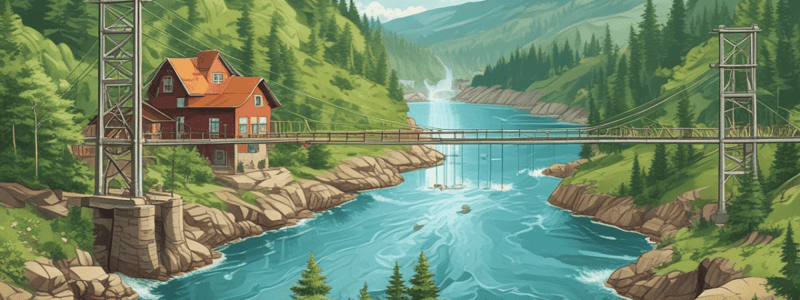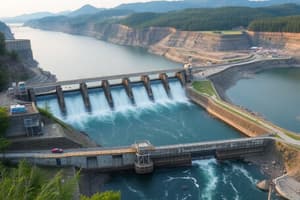Podcast
Questions and Answers
What is the primary force behind the movement of water in the natural world?
What is the primary force behind the movement of water in the natural world?
- Gravity (correct)
- Electricity
- Friction
- Magnetism
What type of energy is produced by hydropower as it flows?
What type of energy is produced by hydropower as it flows?
- Potential energy
- Electromagnetic energy
- Kinetic energy (correct)
- Thermal energy
What was one of the historical uses of hydropower?
What was one of the historical uses of hydropower?
- Powering steam engines
- Powering locomotives
- Milling wheat into flour (correct)
- Generating nuclear power
What invention led to the production of electricity using hydropower?
What invention led to the production of electricity using hydropower?
What is the term used to describe the production of electricity using hydropower?
What is the term used to describe the production of electricity using hydropower?
What percentage of the total clean energy produced in the U.S. is generated by hydroelectric power?
What percentage of the total clean energy produced in the U.S. is generated by hydroelectric power?
What is the primary source of water for hydroelectric power plants?
What is the primary source of water for hydroelectric power plants?
What is the main purpose of building dams in hydroelectric power plants?
What is the main purpose of building dams in hydroelectric power plants?
How is electricity generated in a hydroelectric power plant?
How is electricity generated in a hydroelectric power plant?
What is a benefit of hydroelectric power compared to other forms of energy production?
What is a benefit of hydroelectric power compared to other forms of energy production?
What is a cost-effective aspect of hydroelectric power?
What is a cost-effective aspect of hydroelectric power?
What is a benefit of hydroelectric power in the United States?
What is a benefit of hydroelectric power in the United States?
What is a negative impact of damming waterways on local ecosystems?
What is a negative impact of damming waterways on local ecosystems?
What is a way to mitigate the negative impacts of damming on migratory fish?
What is a way to mitigate the negative impacts of damming on migratory fish?
What is a negative impact of creating reservoirs on local ecosystems?
What is a negative impact of creating reservoirs on local ecosystems?
Flashcards are hidden until you start studying
Study Notes
What is Hydropower?
- Hydropower is the natural force created by water as it moves from areas of high elevation to areas of low elevation.
- Water produces massive amounts of kinetic energy due to the force of gravity pulling it down.
- Kinetic energy is transformed into mechanical energy when humans harness it to perform tasks.
Historical Use of Hydropower
- Historically, hydropower was used to power mills that milled wheat into flour, papermaking, and to power hammers that break and process ore.
- In the late 1700s and 1800s, the invention and use of the turbine led to the production of electricity using hydropower.
Hydroelectric Power
- Hydroelectric power is the use of hydropower for the production of electricity.
- Hydroelectric power was once the leading source of electrical energy in the U.S.
- Today, the U.S. uses hydroelectric power to produce 7.3% of its total generated electricity and 37% of its total clean energy produced.
Electricity Generation
- To produce electricity using water, there must be a flow of water and a turbine connected to an electrical generator.
- The water cycle provides the necessary water for hydroelectric power generation.
- Water from higher elevations flows down through rivers and streams, collecting in larger bodies of water, and eventually becoming groundwater or flowing into the ocean.
How Hydroelectric Power Plants Work
- Hydroelectric power plants are built near rivers, with some having dams that create artificial bodies of stored water (reservoirs).
- Water flows through holes in the dam, turning a turbine, which powers a generator.
- Electricity is produced when the turbine turns a shaft connected to magnetic steel filaments that spin inside a coil of conductive material.
Hydropower Pros and Cons
Benefits of Hydropower
- Hydropower is a renewable resource because water is constantly recycled in the water cycle.
- It is a clean energy resource because it doesn't use fossil fuels that pollute the atmosphere.
- Hydropower is flexible, cost-effective, and can provide a local power source.
Disadvantages of Hydropower
- Damming of waterways can have negative impacts on local ecosystems.
- Creating reservoirs can change water temperature, disrupt ecosystems, and contribute to greenhouse gas emissions.
- Damming can disrupt the natural flow of the river, affecting organisms that rely on it.
Studying That Suits You
Use AI to generate personalized quizzes and flashcards to suit your learning preferences.




